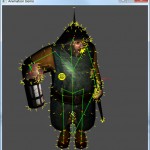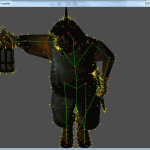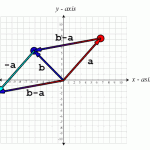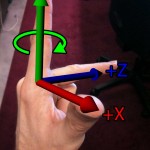This tutorial builds upon the previous article titled [Loading and Animating MD5 Models with OpenGL]. It is highly recommended that you read the previous article before following this one. In this tutorial, I will extend the MD5 model rendering to provide support for GPU skinning. I will also provide an example shader that will perform the vertex skinning in the vertex shader and do per-fragment lighting on the model using a single point light. For a complete discussion on lighting in CgFX, you can refer to my previous article titled [Transformation and Lighting in Cg].
Continue reading
Loading and Animating MD5 Models with OpenGL
In this article, I will show how you can load and animate models loaded from the MD5 model file format. In this article I will use OpenGL to render the models. I will not show how to setup an OpenGL application in this article. If you need to get a quick introduction on setting up an OpenGVL application, you can follow the “Beginning OpenGL for Game Programmers” article [here].
Introduction to DirectX 9 for Game Programmers

DirectX
In this article I will give a quick introduction to DirectX. I will use Visual Studio 2008 as a development environment for this tutorial and I will start by showing how to install DirectX and configure Visual Studio 2008 to start developing DirectX applications. I assume that the reader has basic programming knowledge in C++. If you require a math refresher, you can refer to my “3D Math Primer” articles on Coordinate Spaces, Vector Operations, and Matrices.
3D Math Primer for Game Programmers (Vector Operations)
In this article I would like to discuss operations on vectors. This article assumes the reader has a basic knowledge of what vectors are and how they are represented. My goal here is simply to refresh your memory about what kind of operations can be performed on vectors specifically operations that are important if you are trying to create a 3D game engine.
Continue reading
3D Math Primer for Game Programmers (Matrices)
In this article, I will discuss matrices and operations on matrices. It is assumed that the reader has some experience with Linear Algebra, vectors, operations on vectors, and a basic understanding of matrices.
3D Math Primer for Game Programmers (Coordinate Systems)
In this article, I would like to provide a brief math primer for people who would like to get involved in game programming. This is not an exhaustive explanation of all the math theory that one will have to know in order to be a successful game programmer, but it’s the very minimum amount of information that is necessary to know before you can begin as a game programmer.
This article assumes you have a minimum understanding vectors, and matrices. I will simply show applications of vectors and matrices and how they apply to game programming.





